The Aztecs may be known for being a warrior society but they were also into the arts. Many artisans from the empire created various sculptures and other artifacts that display their excellent skills and depth of artistic knowledge.
Introduction
The Aztecs may be known for being a warrior society but they were also into the arts. Many artisans from the empire created various sculptures and other artifacts that display their excellent skills and depth of artistic knowledge.
In the samples shown below, you will see various styles and designs made using volcanic rock, basalt, wood, shells, and imported turquoise. Most are representations of their different gods, goddesses, and items that are intrinsic to their culture and mythology.
Stone of Tizoc

The Stone of Tizoc, which was carved from basalt around 1485, mixes real-world politics and cosmic mythology. The circular stone, once used as a surface for the performance of human sacrifice, contains detailed relief carvings of the fight between Chichimecs or landless barbarians defeated by the attacking warriors led by Tizoc. The winners wore the noble dress honored by the Toltecs. The upper surface of the stone shows a sun disk with eight points.
Statue of Coatlicue

The Statue of Coatlicue is considered one of the finest examples of sculpture created by the Aztecs. Carved from basalt, the statue stands about 8.3 feet or 2.5 meters, making it a massive stone sculpture that looks too terrifying and imposing. The posture of the goddess also leans slightly forward, adding to its fierce appearance.
The statue shows various detailed features, from two snakes facing each other as her head, intertwining snakes for her skirt, and a belt of doubled-headed snakes with skull fastenings in front and at the back. Her necklace shows alternating hearts and hands. The naked breasts indicate that she had given birth. Her hands and feet had claws, while her joints had death eyes and fangs. It was found in 1790 but was buried several times. It was finally excavated in 1823.
Sun Stone (Aztec Calendar)
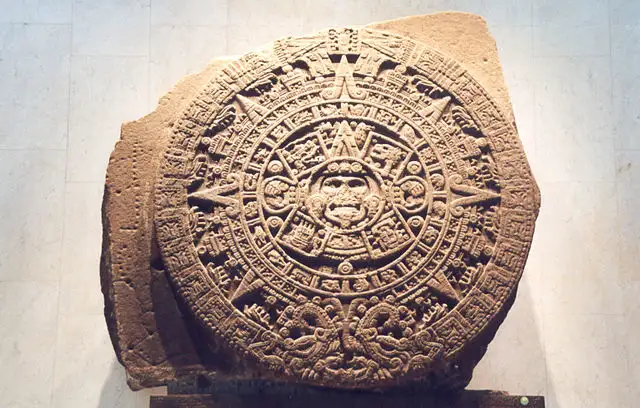
The Stone Calendar or the Sun Stone is a depiction of the Aztec sun’s five worlds. The basalt solar disk measures 3.78 meters in diameter and is one meter thick. Buried for nearly three centuries and discovered in 1790, it weighs about 25 tons. Its central face represents either Tlaltecuhtli, Yohualtonatiuh, or Tonatiuh. Surrounding the central face are the four suns loosely forming an X, while on each lateral side is a jaguar paw or head holding a heart. At the central part of the bottom of the disk are two serpent heads, their bodies encircling the stone’s perimeter and their tails meeting on top.
The Aztecs have a deeper understanding of the universe, time and space, and the passing of days and time. The calendars are interrelated with their religion. The two calendars align every 52 years, and each alignment means that the world will suffer from a great disaster.
Mictlantecuhtli Statue
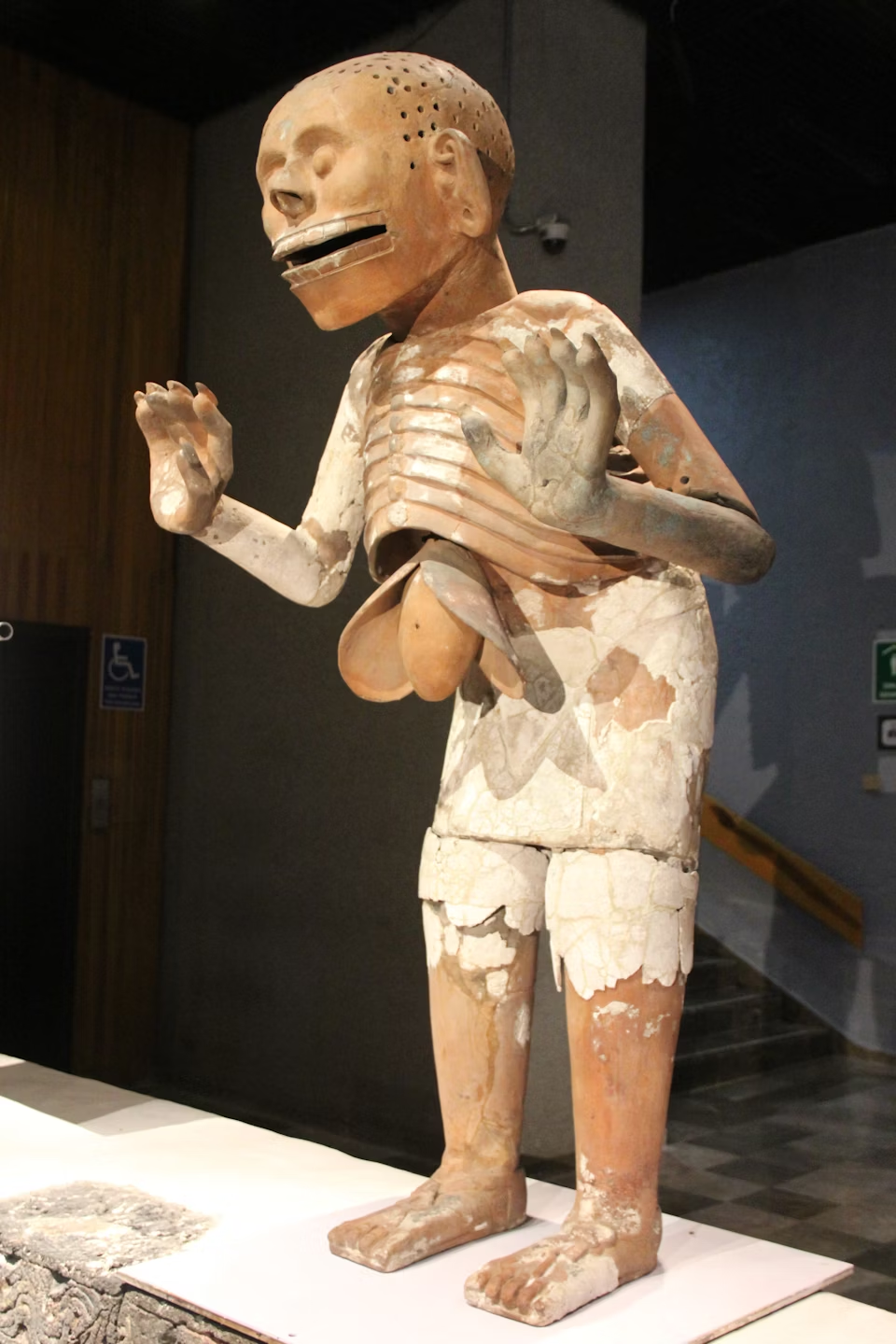
The fired-clay Mictlantecuhtli statue was discovered only in 1994. The statue is about six feet tall and showed much of the god of death’s skin removed, with its liver suspended from its exposed stomach. It has clawed hands and holes in its head, and archeologists believed that it once had hair from humans that their warriors and nobles sacrificed. Aztecs worshipped the ruler of the underworld, who was associated with cannibalism, which the Aztecs performed ritually to appease their gods.
Turquoise Mosaic Mask of Quetzalcoatl

The mask with its intertwined loop of serpents is believed to be the representation of Quetzalcoatl, the rain god. Some historians think it represents Tlaloc, as both gods are associated with snakes. The mask was covered in turquoise mosaic in blue and green, to show the twisting of the two serpents around the eye sockets and across the face.
The mask is made of cedro wood (a type of Spanish cedar), with the mosaics attached to the wood with adhesive made from pine resin. Conch shells were fashioned to form the teeth, while hematite gives the resin adhesive around the mouth its red color. The tails of the snakes used to be gilded.
Moctezuma II, who believed the Spanish conquistador was the reincarnation of Quetzalcoatl, gave Hernán Cortés a similar mask. The mask had a crown of long greenish-blue iridescent feathers which may have come from the quetzal bird.
Double Headed Serpent

The serpent figure is prominent in the religion of the Aztecs. In their language, they called the snake “coatl,” which is associated with many Aztec gods. It may have something to do with the serpent’s habit of shedding its skin, which the Aztecs believed to be related to transformation and renewal. The undulating double-headed serpent could be used during religious ceremonies.
The base is carved Spanish cedar, hollowed at the back and covered with pieces of turquoise mosaic in green and blue. It could be a pectoral (chest) ornament. It has red spiny oysters for accents, with its color enhanced by hematite (red iron oxide), and queen conch shells shaped for its teeth and fangs. The holes for the eyes may have been covered with fool’s gold.
Skull of Tezcatlipoca

The Skull of Tezcatlipoca, a creator god, is decorated with a turquoise mosaic. Tezcatlipoca—often shown with an obsidian mirror and black stripes on his face—was Quetzalcoatl’s foe. The artifact used a human skull for its base. The back part of the skull is cut off and deerskin lined its surface, with a hinged movable jaw. The long deerskin straps indicate that a priest could have worn the skull.
The mosaic pattern used alternating bands of black and bright blue turquoise. The two orbs representing the eyes used polished iron pyrite, surrounded by rings of a white conch shell. Red thorny oyster shell pieces lined the nasal cavity.
Kneeling Figure of Chalchiuhtlicue

The stone sculpture shows the kneeling Aztec water goddess, Chalchiuhtlicue, who is associated with birth, lakes, rivers, and spring water. According to one Aztec legend, Chalchiuhtlicue presided over the fourth sun (realm), which floods destroyed. She is a representation of purity and the water’s pricelessness. The sculpture shows the goddess wearing the traditional headband with large tassels over each ear, a long skirt, and a tasseled shoulder cape called quechquemitl.
Eagle Warrior
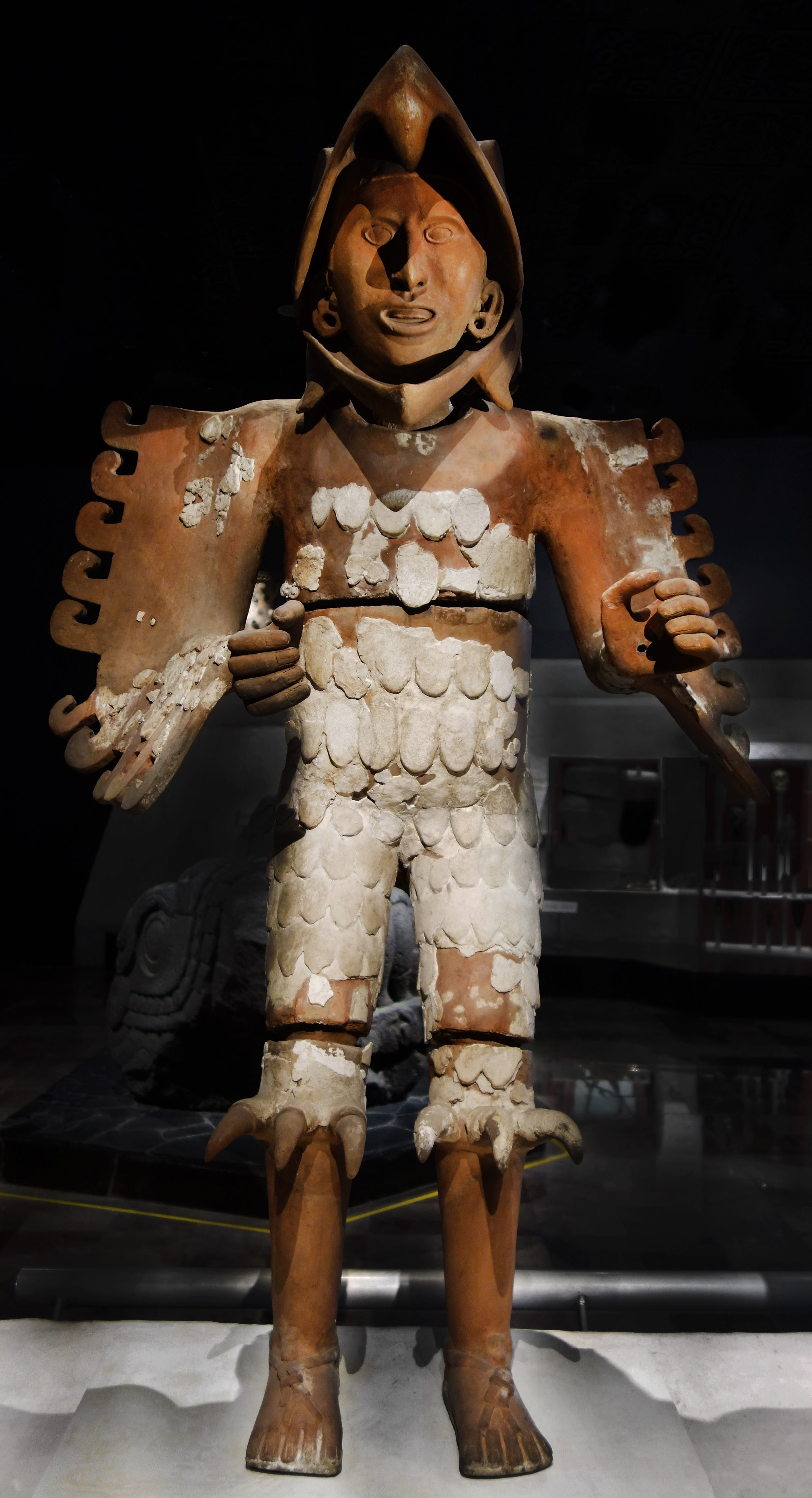
The life-sized ceramic figure of an Eagle Warrior shows the warrior of the eagle class. The terracotta figure shows the reddish color of the medium, although it used to be painted and decorated with feathers. It also used to hold traditional weapons that only elite forces used.
It was discovered at the House of the Eagles at the complex of Templo Mayor. The House of the Eagles was the meeting place of the Aztec elite warriors, the jaguar, and the eagles. The proximity of the warriors’ headquarters to the main temple shows their importance to Aztec culture. According to codices, the eagle warriors’ role was to capture as many prisoners as they could, which they used as human sacrifice.
Xochipilli Statue

Xochipilli was the Aztec god of dance, and his name in Nahuatl translates to Flower Prince. Dance and music played a vital role in the public and religious ceremonies of the Aztecs. This is the most complete sculpture of the Xochipilli, showing him sitting cross-legged on a throne in intoxicated bliss. The god is associated with the arts, sexuality, flowers, and pleasure.
Aztecs saw him as a god capable of practical jokes and lighthearted mischief. His body is covered in intricate patterns and images, which are closely akin to hallucinogenic plants, flowers, and mushrooms. Stylized mushroom caps cover his earlobes. He has a ceramic shell necklace, arm and wrist bracelets, and a headdress with feathers and birds. He was also associated with alcoholic drinks, and music, dances, and poetry were always included in his annual festival. His worshippers ate hallucinogenic mushrooms and drank pulque.
Xiuhcoatl (Fire Serpent)
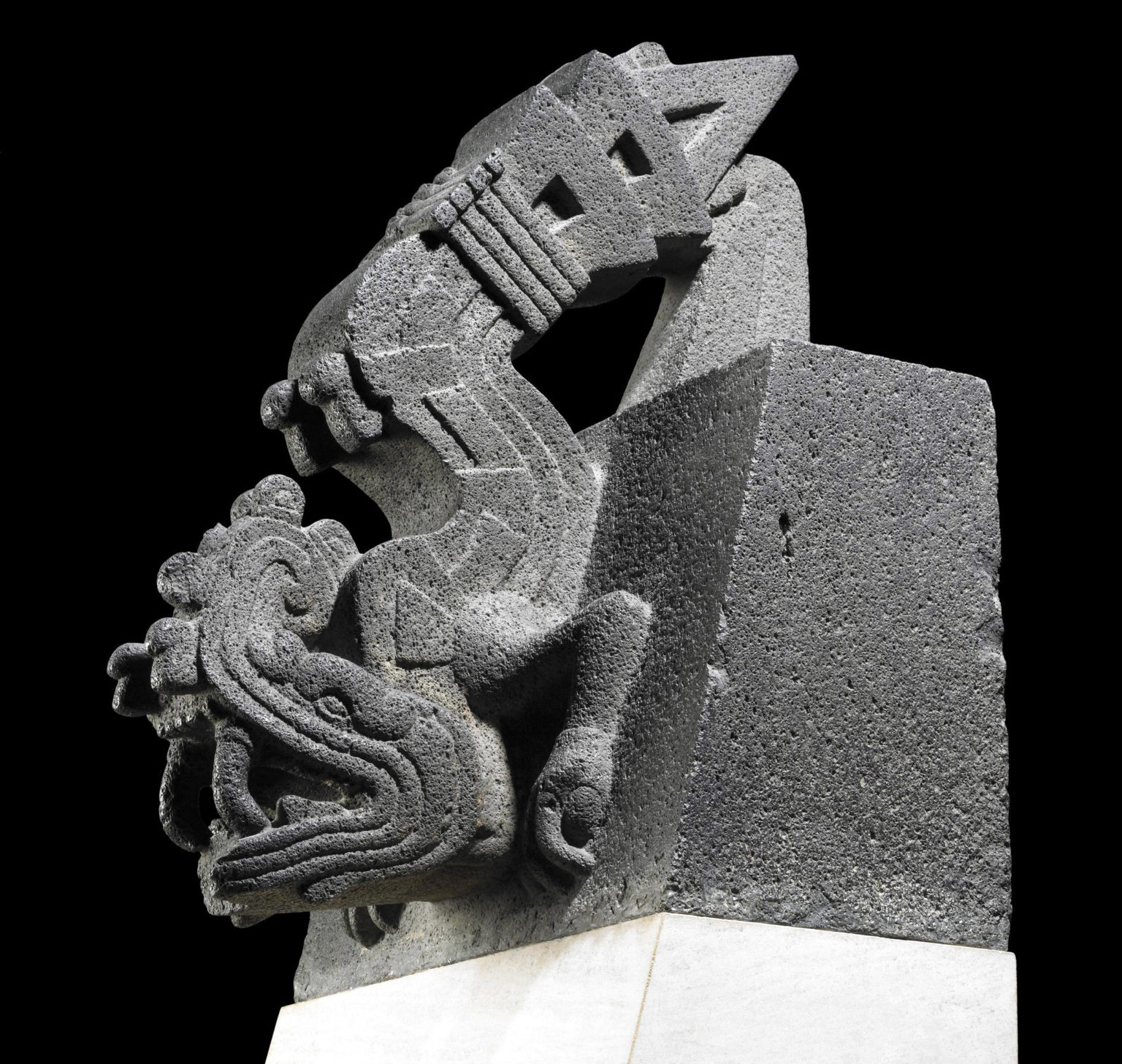
Xiuhcoatl or the fire serpent stone sculpture is an example of the stone sculptures of the Aztecs. This piece represents a rattlesnake, which showed the artist’s excellent skill and realistic rendition of a mythical creature. The piece probably decorated a building façade. It shows the head of a snake in intricate detail. The figure has short legs, with their ends showing claws. The snout of the serpent curves upward, and its tail has two intertwined trapezes and a triangular tail.
Xiuhtecuhtli Mask
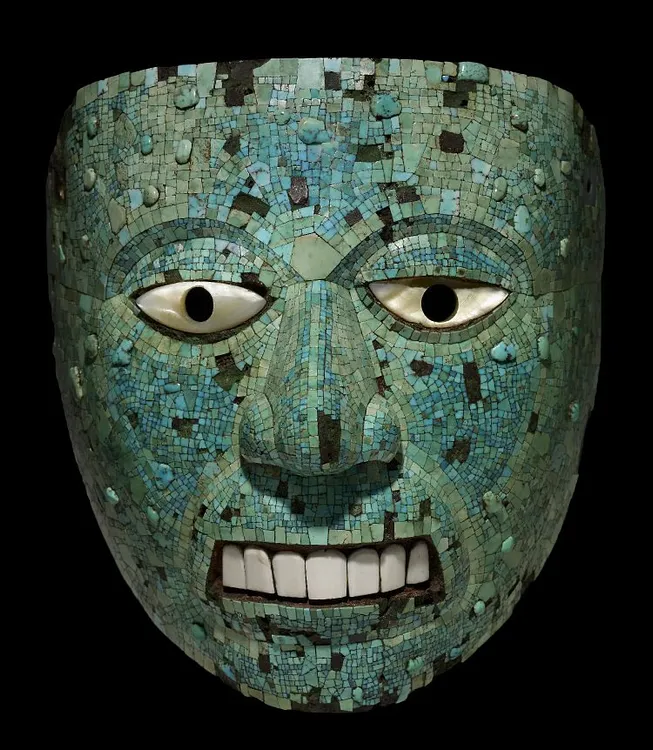
This turquoise mosaic mask represents Xiuhtecuhtli, the god of fire. The mask, measuring 16.5 cm x 15.2 cm, is carved from Spanish cedar, adorned with conch shell teeth, mother-of-pearl eyes, and hundreds of hand-cut and shaped turquoise pieces, glued with pine resin. The artist showed a 3D effect by contouring the wooden base and using different colored turquoise stones. The underside of the mask is painted with red hematite.
The artist cut the mosaic pieces for the eyes, mouth, nose, and eyebrows with precision. Originally, wafer-thin gold foil gilded the eyelids. The exposed seven teeth were made from conch shells. The two holes at the temple of the mask mean that a god impersonator wore it during ceremonies or a god’s effigy during ceremonies performed for royal burials.
Ocelotl (Jaguar) Cuauhxicalli

The huge stone sculpture known as the Ocelotl Cuauhxicalli, carved from volcanic rock, shows the face of a jaguar ferociously snarling at someone or something. The jungle animal stares menacingly. The nostrils are flared, the ears are drawn back, and the fangs are bared as if ready to strike.
The enormous bowl-shaped jaguar receptacle was an altar. Priests used the deep bowl to hold the hearts of their sacrificial humans. They would burn these hearts later as offering to their gods. The Aztecs believed that the heart is the life force or soul of a person. Thus, they used them for their ritual offering as a way to honor and nourish their gods, who created their world.
Using the jaguar is symbolic, as the Aztec associate the animal to combat and war.
Golden Serpent Lip Piercing

The Aztecs practiced body piercing, and one of the finest examples is the serpent labret with an articulated tongue. It is a gold lip plug cast in the lost-wax process. The tongue was cast separately and attached to the main piece. The wearer can extend or retract the tongue. It also swings from side to side when the wearer moves.
The Aztecs typically wore the labret as a piercing below the lower lip. It is quite big, as it measures 1.75 in (4.4 cm) wide, 2.625 in (6.67 cm) deep, and 2.625 in (6.67 cm) high. It is made from an alloy of gold, copper, and silver, and weighs 51 grams or 1.81 ounces. The serpent labret is attached to a cylindrical plug. The plug has a plain, wide flange to hold the ornament in place in the user’s mouth.
Coiled Rattlesnake
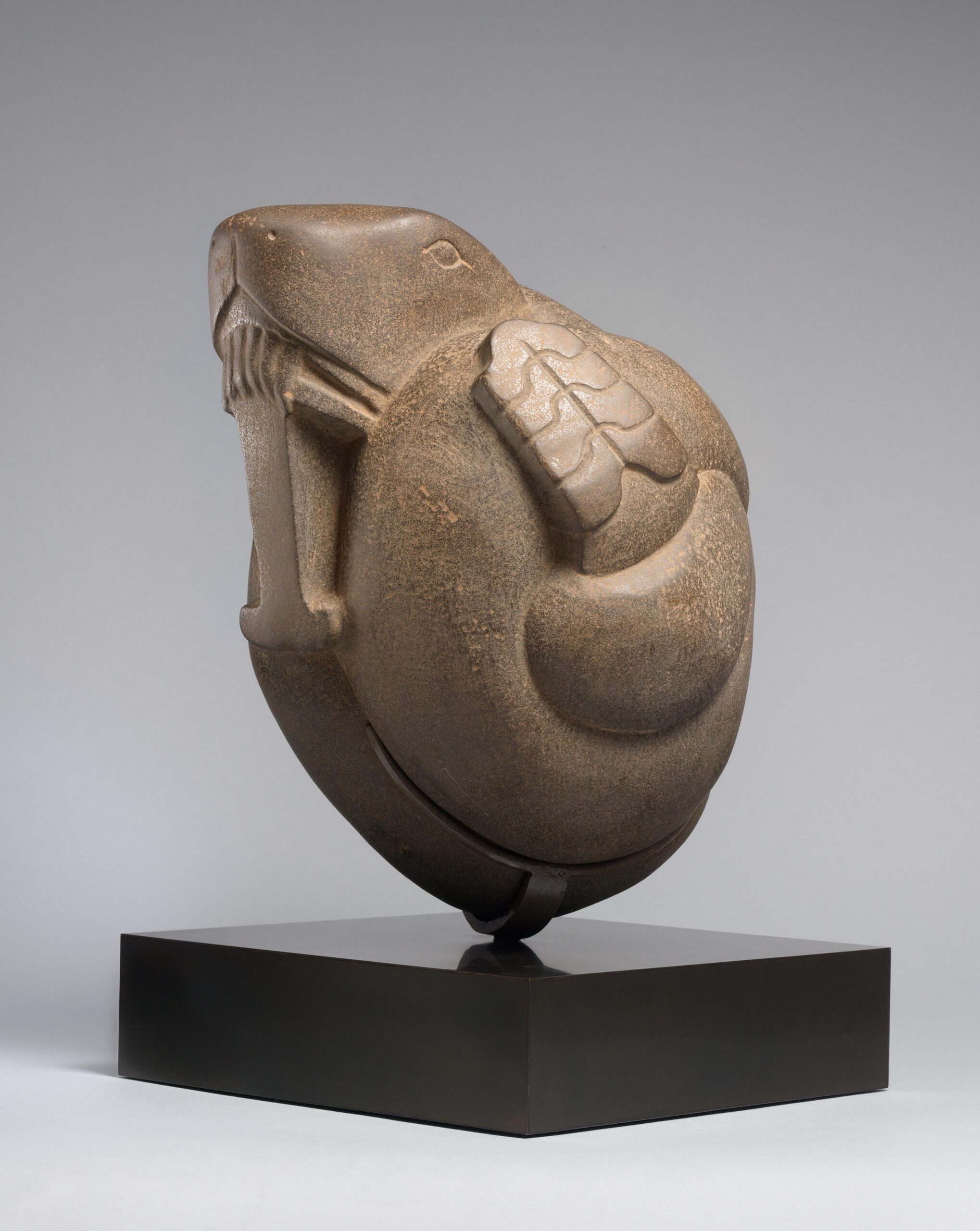
This beautiful piece of sculpture shows the artistry of the Aztec artisans and their skills in using various art mediums. The Coiled Rattlesnake, carved from volcanic stone, shows a tightly coiled snake that prominently shows the head and its rattle. The sculpture measures 21 inches deep, 11 inches wide, and 10.5 inches high.
Many coiled snake sculptures from the Aztecs were found during the excavations of the Aztec Empire’s site, made from different mediums and various designs.
Feathered Headdress of Moctezuma

The Feathered Headdress, which probably belonged to Moctezuma II, is a famous one. It became the symbol of the indigenous and national identity of Mexicans.
The headdress is 175 cm (69 in) across and 116 cm (46 in) high. Feathers are arranged in a semicircle pattern. The smallest semicircle has blue feathers from the lovely cotinga bird (Cotinga amabilis), interspersed with half-moon-shaped gold plates. Behind the first layer is a layer of feathers from the Roseate spoonbill, followed by small feathers from the quetzal bird, then a layer of the white-tipped red-brown squirrel cuckoo feathers.
Three bands of small gold plates surround the shorter feathers. The final two layers have 400 pieces of quetzal tail feathers, placed closely together, with the center feathers raised for effect. It fastens to the head of the wearer with leather straps.
Contents
- 1 Stone of Tizoc
- 2 Statue of Coatlicue
- 3 Sun Stone (Aztec Calendar)
- 4 Mictlantecuhtli Statue
- 5 Turquoise Mosaic Mask of Quetzalcoatl
- 6 Double Headed Serpent
- 7 Skull of Tezcatlipoca
- 8 Kneeling Figure of Chalchiuhtlicue
- 9 Eagle Warrior
- 10 Xochipilli Statue
- 11 Xiuhcoatl (Fire Serpent)
- 12 Xiuhtecuhtli Mask
- 13 Ocelotl (Jaguar) Cuauhxicalli
- 14 Golden Serpent Lip Piercing
- 15 Coiled Rattlesnake
- 16 Feathered Headdress of Moctezuma